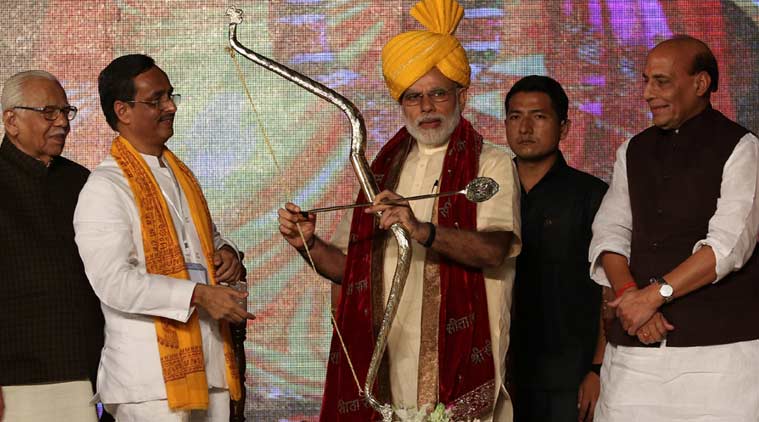Politics is all about opportunity and how politicians make use of it. Government uses every possible opportunity to push its agenda and the opposition exploits them to find loopholes in government’s agendas to vilify them. It won’t be naïve to assume that Politics is a game of capitalizing on Opportunities.
Dussehra is one such opportunity. It is the concluding day of the 9-day long festivity. The underlying symbolism of “Triumph of good over evil” is just the right Launchpad to push agendas and tom-tom about achievements.
PM Modi’s decision to attend Dussehra at Lucknow’s Aishbagh instead of Delhi was a deviation from the set traditions. And it would be absolutely stupid to assume that Modi’s decision to attend Dussehra in Aishbagh was devoid of any political intentions.
This was the perfect opportunity for Modi to boast about the Surgical Strikes in PoK and how the good (Modi Government) vanquished the Evil (Terror Launch Pads in Pakistan)? It was also the perfect occasion for Modi to brag about how they avenged the defamation of India (Uri Attack), much like Bhagwan Ram avenged Sita’s humiliation when he slayed Ravan.
But here comes Modi, radiating his Hindu Charms, raising full-throated chants of “Jai Shri Ram”, likening common Janata with Jatayu, calling Terrorism the ultimate evil, firming his pitch for women empowerment, making veiled attacks at both Pakistan and China and talking about development and economy and wellbeing of the nation.
The opposition wanted him to brag about avenging Uri and the surgical strikes but they were left frothing at their mouths. Modi gave them no option to accuse him of chest-thumping and using national issues to pursue political goals.
So what did Modi achieve with his Dussehra Speech?
Many things. This was one of the shortest and one of the most hard-hitting Modi speeches ever. Let us carefully look at the issues he raised:
Terrorism – The Ultimate Evil:
Modi fully knows that every speech of his undergoes a media scrutiny – both national and international. Currently India is leading the diplomatic war against Pakistan and Modi has been largely successful in cornering Pakistan in the matter of terrorism.
Barring China, every nation big or small has pledged support to India. Even China stayed away from commenting about the Surgical Strikes or Sharif’s Kashmir rhetoric at UNGA 2016. United States will soon be reviewing a public petition that attempts to declare Pakistan a terrorist state.
By calling Terrorism the ultimate evil in a poll bound state, Modi reiterated his stand. It’s us Vs all, he said taking a dig at the intellectual terrorists in India. Rahul Gandhi, Arvind Kejriwal and Sita Ram Yechuri led the anti-Modi bandwagon at the time of the JNU episode where a handful of students raised anti-India and pro-Afzal slogans. Modi doesn’t just attack Pakistan in his reference to terrorism and his promise that the ‘good’ will ultimately prevail, he even attacks those in the polity who have a soft corner for terrorists.
And he goes ahead and calls people Jatayu who as per Modi was the first ever being to confront terrorism. While the buzz in the media is that this was Modi’s plank to lure the Dalits in his fold but the symbolism is too convoluted to deduce that. Jatayu was of demi-god origins hence he cannot be equated to Dalits of modern times and even if he was, how many can actually decipher that? Next to none.
By equating common people with Jatayu, Modi isn’t telling the janata to take on terrorists literally but to take on those who harbor terrorism for petty political gains.
Women Empowerment
One of the highlights of Modi’s address yesterday was his repeated mention of women empowerment and the need to curb social evils like female infanticide. Many Sitas are killed in the womb itself, Modi said. Such statements when made on occasions when the mood is overly religious, reap rich rewards. One statement cannot change the society’s mentality but can surely act as a catalyst for a social renaissance.
Also, when Modi was talking about Women Empowerment, he was addressing 47.6% potential voters in Uttar Pradesh. While analysts focus on caste and religion breakup before every election, they fail to consider women as a separate voting unit with different set of issues and aspirations. Women from almost every caste group voted for Nitish Kumar in the Bihar Assembly Elections as he introduced a large number of women safety and empowerment measures in his first tenure. Prohibition of Alcohol is him taking his women-friendly policies to the next level.
Jai Shri Ram
It was possibly for the first time that an Indian prime minister raised a loud religious call of “Jai Shri Ram” on the occasion of Dussehra. “Jai Shri Ram” was used excessively in the late 80s and early 90s when the Ramjanmabhoomi issue was gaining momentum. “Jai Shri Ram” has since been a religious cry that politicians generally avoid.
But Modi was not just raising the call of Jai Shri Ram, he was actually asking the audience to join the chore too. He looked absolutely comfortable and under no pressure while chanting Jai Shri Ram.
The message is loud and clear. After his remark rebuking ‘fake’ Gau-Rakshaks and the Uri Attack, a sizeable number of Hindu followers got disenchanted with Modi but the Surgical Strikes and diplomatic isolation of Pakistan has brought them back. The name of Ram unites every Hindu, cutting caste lines. And the name of Ram will echo in UP Elections 2017.
This was no ordinary Dussehra speech. Modi was standing amidst land-mines waiting to blow up his goodwill. But being the spellbinding orator and the astute politician that he is, Modi didn’t just deliver a powerful speech, he delivered a crushing blow to the opposition.
